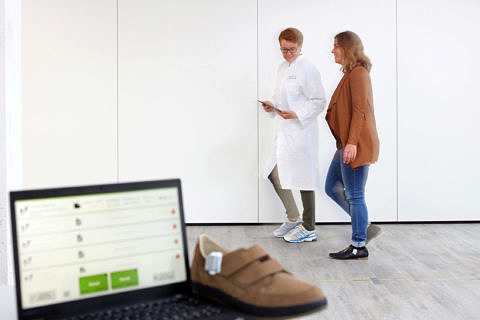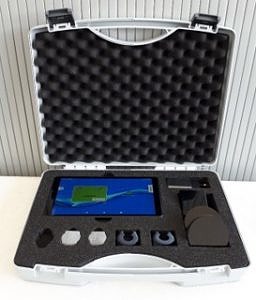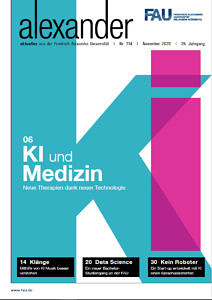How technology is transformed into personalised medicine

Physician Prof. Dr. Jochen Klucken and computer scientist Prof. Dr. Björn Eskofier use artificial intelligence to develop new therapies for treating patients with Parkinson’s disease.
Everyone is talking about personalised medicine these days, which is understandable as we would all like advice and treatments tailored to our individual needs. However, the concept of personalised medicine has not really taken off in practice yet. Standard treatments still tend to be the first choice, even though their limited scope for adaptation means that they often cannot meet patients’ individual requirements. There are some exceptions, of course. Personalised treatments are used, at least in part, where standard treatments do not work, such as in the treatment of cancer.
The team of researchers led by Prof. Dr. Jochen Klucken, deputy head of the Department of Molecular Neurology at Universitätsklinikum Erlangen and Prof. Björn Eskofier, Chair of Computer Science 14 (Machine Learning and Data Analysis) are taking the concept further by using artificial intelligence (AI) to adapt treatments for motor disorders such as Parkinson’s to patients’ individual needs, thus improving their quality of life. In conjunction with Portabiles HealthCare Technologies, a start-up based in Erlangen, they have developed a wearable ‘laboratory in a shoe’ equipped with sensors that measures the individual gait characteristics of patients with Parkinson’s. This shoe known as the ‘Mobile GaitLab’ has recently been certified as a medical product and measures various parameters which play a role in walking ability and stability such as pace length. The collected data are visualised using a computer program which enables doctors to precisely categorise the severity of the disease, detect even the smallest of changes in gait quality at a glance, and above all, to adapt treatment to the patient’s individual needs.

Picture: Kurt Fuchs
From the idea to implementation
What does AI have to do with the development of a medical device like this? A great deal, as it turns out, as it would not be possible without learning algorithms. How did Prof. Klucken and Prof. Eskofier set about developing a personalised diagnostic unit – a device that individually records and documents the most important symptoms of a medical condition? ‘The first step is to define the parameters that the device should measure and that match up exactly to the symptoms, such as restricted mobility,’ says Prof. Klucken. ‘Secondly, you need to find out if sensors measure the parameters more accurately than medical staff would with current diagnostic methods.’ In addition, the parameters selected must also provide information about how effective the treatment is for the patient and how the disease is expected to progress. ‘The question is whether the sensors not only perform accurate measurements, but also if they can detect the influence of the treatment or changes to disease progression. The diagnostic test method has to be very sensitive and react to even the slightest of changes,’ explains Prof. Eskofier. This is where AI comes in. By analysing data sets, artificial intelligence can determine whether the selected parameter not only detects changes in larger populations, but also if this parameter could be useful for individual patients. AI processes all the available information and assigns it to each individual patient, for example if one patient has received treatment, while another has not and, in the case of Parkinson’s, whether the treatment has improved the treated patients’ ability to walk or not. By comparing data, it can also provide information about whether a change in three centimetres in pace length actually does mean that the treatment is not sufficient and needs to be adapted. AI also detects if and which changes in gait quality enable statements to be made about disease progression. The algorithm detects patterns and is adaptive, which means it can even detect parameters that the researchers themselves may have overlooked.


and visualizes the obtained data. (Picture: Portabiles HealthCare Technologies)
‘Profiling’ in medicine
To personalise this technology, patient profiles are created using algorithms that comprise gender, duration of disease, previous treatment, disease progression and much more. The algorithm can subsequently group together patients with similar profiles, enabling researchers to compare the symptoms and how they develop. The researchers are then able to determine if a change in a certain parameter in this particular group represents a change in the disease progression that may require adjustments to treatment. The researchers can validate this information by asking doctors and patients to see whether they come to conclusions that are similar to those of the algorithm.

deputy head of the
Molecular Neurology at the
University Hospital Erlangen. (Picture: Valentin Schilling)
Data provider for treatment decisions
By using the data previously collected about a patient, AI can determine how the patient’s condition has changed over time, when which treatments were used and which treatments have led to an improvement in the patient’s health, to determine what has been particularly useful to the patient. AI can also quickly detect signs that a patient’s health has deteriorated further and if this is because they are not receiving adequate treatment or whether the progression of the disease cannot be stopped. ‘AI provides doctors with data that can support them in making decisions about treatments, but does not make these decisions itself,’ says Prof. Klucken.
Medicine and IT: A strong combination
Prof. Klucken describes how the computer scientists and medical researchers work together: ‘I ask the medical questions, Björn Eskofier develops the technical solutions, in other words, how an algorithm can evaluate the data to recognise patterns. I consider how the data must be visualised on an individual level so that the medical staff providing treatment can quickly make decisions. I also check how the patient copes with a wearable and the sensors to make sure that they use it.’ Jochen Klucken and Björn Eskofier are convinced that AI will play a greater role in medicine during the next few years – to evaluate large amounts of patient data, draw conclusions from them and thus personalise treatment for patients.
‘It may be possible in the future for wearables, which could also be used in geriatric medicine, to suggest changes to treatments to patients and their doctors, allowing medical staff to devote more of their time to communicating with their patients,’
However, a great deal more research is needed before this happens and before patients, doctors, therapists and society can accept these systems.
alexander – Aktuelles aus der FAU
Die aktuelle Ausgabe richtet den Focus auf die Künstliche Intelligenz: Klangmuster in der Musik werden mittels KI identifiziert, KI kommt in der personalisierten Medizin zum Einsatz und KI verbessert Prozesse in Unternehmen. Vorgestellt wird auch der neue Bachelor-Studiengang Data Science und ein Start-up, welches mit KI einen Sprachassistenten entwickelt.
FAU-Magazin alexander Nr. 114 (Oktober 2020)
Einzelne Exemplare liegen an der FAU aus. Gerne können Sie sich das Magazin auch kostenlos nach Hause oder an den Arbeitsplatz schicken lassen. Bitte füllen Sie dafür unser Abo-Formular aus.
Ausgewählte Beiträge können Sie auch online lesen in unserem Blog „FAU aktuell“.
